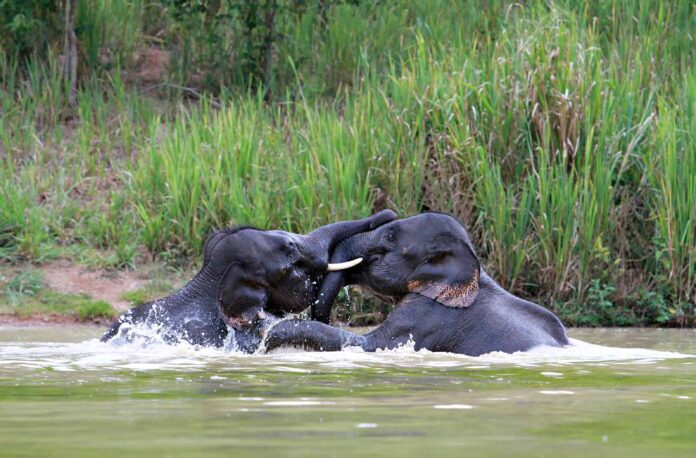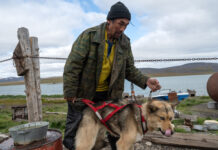….How one non-profit organisation is encouraging alternative crops to reduce human–elephant conflict in Thailand.
Text Sarah Eichstadt
When elephants enter her farm, Roengrom “Rom” Amsamarng runs away and spreads the news of elephant presence to neighbouring farms. To Rom, a Thai farmer, elephants threaten her safety and economic livelihood. In the village of Ruam Thai, where Rom lives, elephants leave protected areas and venture into pineapple farms, damaging crops that farmers depend on for a living. “If it’s too late at night, I won’t go out or even move,” Rom says. “If the elephant is really close to me, I won’t move, but if the elephants are far away, I will run as far as I can.” This is an example of human–elephant conflict, a problem in all 13 countries inhabited by Asian elephants, including Cambodia, Thailand and Sri Lanka. In Thailand, human–elephant conflict, or HEC, is increasing. Research suggests this is the result of shrinking Thai forestland. Between 2012 and 2017, 45 humans and 25 elephants died through HEC, according to Thai newspaper The Nation.
Ruam Thai village is working to solve this problem. A group of farmers, researchers and volunteers is experimenting with how to make the plantations less appealing to elephants.
Most Ruam Thai village residents’ main source of income is from agriculture, and 70 percent of these residents plant pineapple. The village in the southwestern province of Prachuap Khiri Khan, about 250 kilometres south of Bangkok, shares an unfenced border with Kuiburi National Park, home to more than 300 wild elephants. By helping farmers transition to planting different crops instead of pineapple, Bring The Elephant Home, or BTEH, is “working with elephant psychology”, as BTEH’s Thailand country director Ave Owen calls it, to disincentivise them from coming into the farms.
BRINGING THE ELEPHANTS HOME
Bring the Elephant Home is a non-profit organisation based in the Netherlands, South Africa and Thailand that works to promote human–elephant coexistence and ensure the future survival of elephants. BTEH was founded by Antoinette van de Water in 2004. Originally from the Netherlands, Antoinette became interested in elephant conservation when volunteering at Elephant Nature Park, an elephant rescue and rehabilitation centre in northern Thailand. Over the years, BTEH has evolved to encompass a more holistic vision of elephant conservation. This means incorporating biodiversity and local communities into BTEH’s mission. Electric fences are responsible for 72 percent of HEC-related elephant deaths, while most humans who die from HEC are killed trying to keep elephants away. Instead of using traditional methods like fences to deter elephants from coming into the Ruam Thai village, BTEH wondered if planting crops that were unpalatable to elephants would eliminate their motivation to leave the protected area and enter agricultural areas. Realising minimal research on alternative crops and elephants had been done, BTEH partnered with community leaders in Ruam Thai who were interested in trialling alternative crops to see which crops would be consumed and avoided by elephants. BTEH researchers and local farmers brainstormed crops elephants don’t eat that are also marketable and drought resistant.

The Tom Yum Project
Feature
| Finding Harmony Between Humans and Elephants The Tom Yum Project, named after the Thai soup, was born in March 2021. The ingredients for the well-known spicy soup are chilli, garlic, lemongrass, galangal, kaffir lime, onion and coriander – none of which are attractive to elephants. The findings of the initial study, conducted by BTEH, Miami University and Ruam Thai community members, gives hope to alternative crops as a solution to HEC in the village. The trial alternative crops – lemongrass, citronella, chilli, lime, kaffir lime, karonda, mulberry, galangal, turmeric and Cassumunar ginger – were not uprooted or consumed by elephants. The only damage was some trampling, which affected less than 10 percent of experimental crop. It was a different story for the pineapple crops in the study. Elephants had consumed 100 percent of the pineapple after 11 months; 97.5 percent of it was consumed in the first two months. Farmers involved in The Tom Yum Project turn the alternative crops into organic soaps, candles, teas and honey, sold in consignment stores across Thailand and globally on the Elephant & Co webshop.
Relearning the Game
Pineapple has been the main cash crop in Ruam Thai for over two decades. Asking local farmers to switch to different crops is a major change to the way many farmers learned how to make a living from agriculture. Many have financial concerns and are unsure how elephants will interact with alternative crops. Ave Owen researched the alternative crops for their master’s dissertation. While confident that elephants don’t damage these alternative crops, they understand how transitioning could be challenging or farmers. Ave says: “I have deep sympathy for how scary it is for a farmer to think ‘I’ve been planting pineapple my whole life. And I learned how to plant that pineapple from my father and mother, who planted pineapple for their whole lives. And you’re now telling me I’m about to change?’” Farmers also have to relearn how to properly cultivate these crops, such as how much water they need. BTEH put together workshops to help farmers learn how to make the products themselves rather than solely selling the crop yield to a factory. This gives more direct economic power to the farmers by shortening the supply chain. Rom, a member of The Tom Yum Project, plans to experiment with planting alternative crops in the near future. She feels that she is too old to continue night guarding her farms to prevent elephants from coming. Joining The Tom Yum Project has given her hope for another solution that can provide income and prevent elephants from coming into her farm. “Before joining the team, I was just planting palm, coconut and pineapple. These crops can give me financial return in the future, because I do not have children to take care of me when I’m old,” Rom says. “Since I joined The Tom Yum Project, I realised that there are a number of crops unpalatable for elephants. I would like to try planting them.”

Boosting Biodiversity
Ave points out that maintaining pineapple farms generally requires chemical herbicides, fertilisers and growth hormones. This contaminates the water and air, negatively impacting wildlife and human health. One of The Tom Yum Project’s goals is to stop relying on chemicals for crops. Various alternative crops don’t require herbicides, opening up the possibility for more organic farming. In turn, organic farming improves biodiversity, which BTEH sees as a benefit to all species, including humans. “The Tom Yum Project represents the coexistence of all species and the way those species live with each other,” Ave says. “There’s a reciprocal relationship of humans investing into biodiversity.” Organic regenerative agriculture is better for the environment, Ave adds, resulting in more pollinators that can help increase crop yield. A 2018 study on legumes in Thailand found that organic farming improved soil quality on biological, chemical and physical measures. Soil productivity improved, while both soil organic matter and rates of decomposition increased.
Challenges
The biggest challenge to The Tom Yum Project is economics. A question yet to be answered: Can alternative crops become more profitable than pineapple, and how can this be achieved? Nearly three years since the original trial, alternative crop planting has only been tested on small farms, but a group of about 15 local farmers is ready to scale up their efforts this year. Elephant presence in farmland comes with financial consequences because of the crops they damage, but it is also an emotional stressor. The relief that alternative crop farming can bring may outweigh the economic gamble. “Even if the alternative crop income is a little bit lower, the farmers might still be tempted by all the psychological benefits they’ll get,” Ave says. “Being able to rest and get home, not being so worried and stressed all the time about the elephants damaging their crops.” BTEH sees its role as co creators of research that provides information about the economics of the project and elephants’ interaction with crop species. How to farm is a decision ultimately left up to those most directly affected, the farmers. “I think these farmers will have great trust in each other,” Ave enthuses. “If they have a positive experience with this model, they’ll share that experience with their neighbors. The project will grow naturally.”

Collaborative Community
BTEH values its human relationships as much as elephant conservation. Everyone comes to meetings and has an equal voice at the table. “Elephant conservation cannot be looked at with tunnel vision,” declares Ave. “Elephants are one of the puzzle pieces of this mosaic of environmental conservation. That interconnectedness and interdependency includes humans.” Akaraphum “Phum” Pisanwanich, a project manager for BTEH, has worked for other organisations in Thailand that claim to champion helping local communities. He described some of these groups as exploitive of local communities. Phum says The Tom Yum Project truly prioritises local community. He notes that when he started as project manager, Ave told him that The Tom Yum Project should be owned by the community, not BTEH staff. “There’s no hierarchy,” Phum says. “The energy of the people is amazing. It’s almost addictive. I love to be here.” Phum sees a lack of HEC research in Thailand. His dream for BTEH is to integrate the organisation into college courses to “inspire new generations of researchers” who can continue working towards human–elephant coexistence in Ruam Thai village and beyond.
Beyond Thailand
The Tom Yum Project is the first research and community-based alternative crop planting initiative to promote human–elephant coexistence in Thailand. But BTEH hopes that many other countries can benefit from the experiences in Thailand. Through a research collaboration with Dr. Shermin de Silva of Trunks & Leaves, a similar project will be implemented in Sri Lanka. Together, the researchers plan to study the effects of alternative crops in Sri Lanka and Thailand. Their hope is that growing alternative crops can serve as a model for other countries seeking human–elephant coexistence. “We can cover this continent in fences and warning cameras and guarding teams,” says Ave, “but solutions that prioritise the wellbeing of humans, wildlife and ecosystems are going to be able to solve this problem while we resolve broader issues facing the natural world.”











